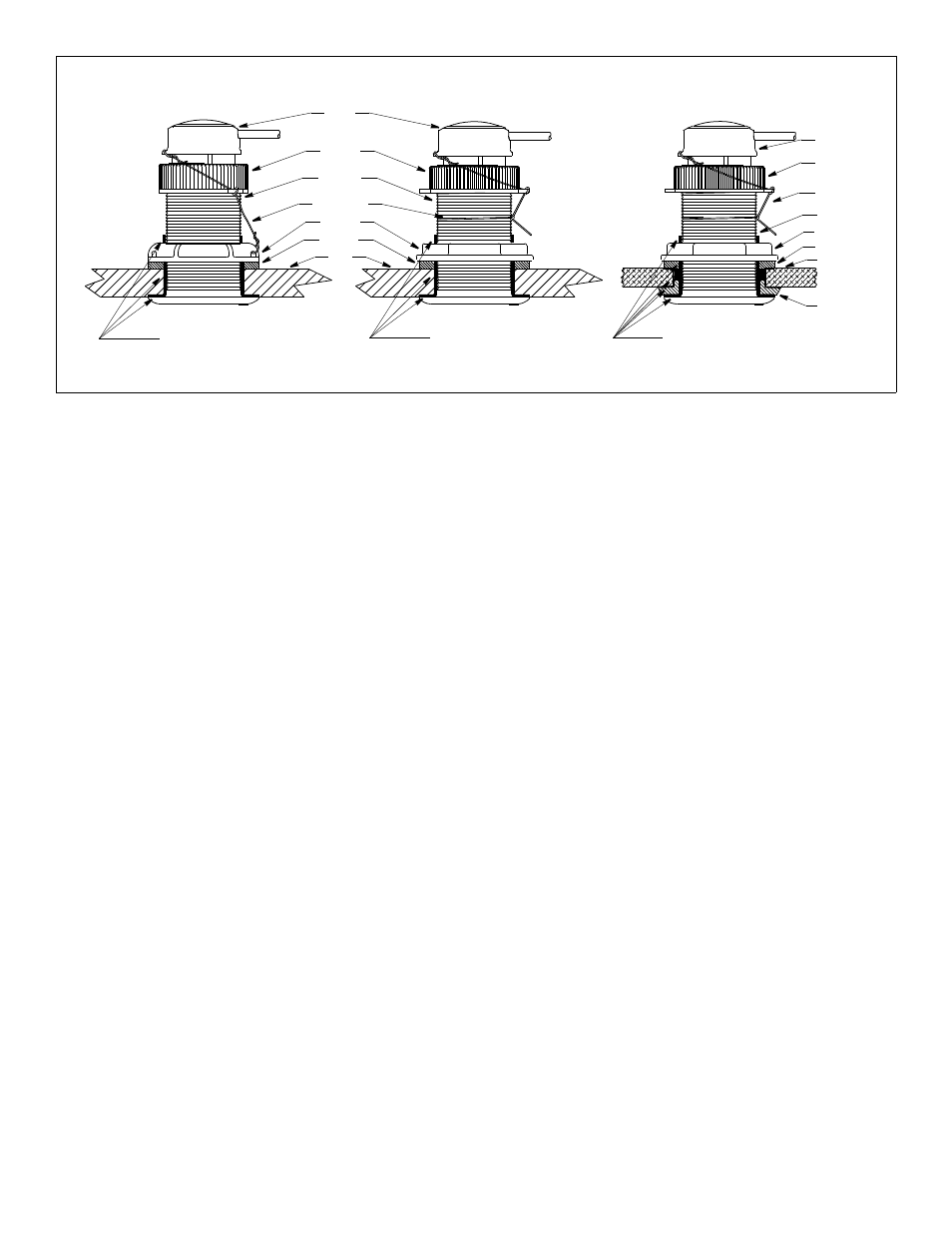Installing in housing without valve, Checking for leaks, Installing – Airmar Tilted Element™ Retractable with Valve—DT800: 0°/12°/20° User Manual
Page 3: Cable routing & connecting

Stainless steel housing in a metal hull—To prevent electrolytic
corrosion, the stainless steel housing must be isolated from the
metal hull. Slide the isolation bushing onto the housing. Apply
additional sealant to the surfaces of the isolation bushing that will
contact the hull, filling any cavities in and around the bushing.
Installing
NOTE: Disregard any arrow on the housing; it is not used.
1. From outside the hull, push the housing into the mounting hole
using a twisting motion to squeeze out excess sealant.
2. From inside the hull, slide the washer onto the housing (see
Figure 5).
Stainless steel housing in a metal hull—Be sure the washer
contacts the hull. Do not tighten the hull nut with the washer
against the isolation bushing, as the housing will not be firmly
installed. If necessary, sand the isolation bushing until the
washer rests against the hull.
3. Screw the hull nut in place.
Plastic hull nut—Hand-tighten only. Do not over tighten.
Metal hull nut—Tighten with slip-joint pliers.
Cored fiberglass hull—Do not over tighten, crushing the hull.
Wood hull—Allow the wood to swell before tightening the hull nut.
4. Remove any excess marine sealant on the outside of the hull to
ensure smooth water flow under the transducer.
5. After the marine sealant cures, inspect the O-rings on the insert
(replace if necessary) and lubricate them with the silicone
lubricant supplied (see Figure 4). Be sure the YELLOW O-ring
is in place near the top. O-rings must be intact and well
lubricated to make a watertight seal. Also lubricate the bore of
the housing above the valve.
6. Slide the insert into the housing with the arrow on the top
pointing toward the KEEL or centerline of the boat (see
Figure 1). Be sure the insert is fully inserted.
7. Screw the cap nut several turns until the threads are engaged.
Being sure the arrow on the top of the insert and the cable exit
are pointing toward the keel/centerline, continue to tighten the
cap nut completely. Be careful not to rotate the housing and
disturb the sealant. Hand tighten only. Do not over tighten.
8. Attach the safety wire to prevent the insert from backing out in
the unlikely event that the cap nut fails or is screwed on
incorrectly (see Figure 5).
Plastic housing—Attach the safety wire to one eye in the hull
nut. Keeping the wire taut throughout, lead the wire in a
counterclockwise direction and thread it through one eye in the
cap nut. Thread the wire through the eye a second time. Then
lead the wire through the eye in the insert. Twist the wire
securely to itself.
Metal housing—Wrap one end of the safety wire tightly around
the housing and twist it together with the long end. Keeping the
wire taut throughout, lead the wire straight up and through one
eye in the cap nut. Thread the wire through the eye a second
time. Then lead the wire counterclockwise and through the eye
in the insert. Twist the wire securely to itself.
Installing in Housing WITHOUT Valve
To create a watertight seal in a housing that does NOT have a
valve, the insert must have a BLACK O-ring near the top. Use
Replacement O-ring Kit 20-519-01 and follow the instructions
supplied.
Cable Routing & Connecting
CAUTION: If your transducer came with a connector, do not
remove it to ease cable routing. If the cable must be cut and
spliced, use Airmar’s splash-proof Junction Box No. 33-035 and
follow the instructions provided. Removing the waterproof
connector or cutting the cable, except when using a watertight
junction box, will void the transducer warranty.
1. Route the cable to the instrument being careful not to tear the
cable jacket when passing it through the bulkhead(s) and other
parts of the boat. Use grommets to prevent chaffing. To reduce
electrical interference, separate the transducer cable from other
electrical wiring and the engine. Coil any excess cable and
secure it in place with cable ties to prevent damage.
2. Refer to the instrument owner’s manual to connect the
transducer to the instrument.
Checking for Leaks
When the boat is placed in the water, immediately check around
the thru-hull transducer for leaks. Note that very small leaks may
not be readily observed. Do not leave the boat in the water for
more than 3 hours before checking it again. If there is a small
leak, there may be considerable bilge water accumulation after 24
hours. If a leak is observed, repeat “Bedding” and “Installing”
immediately (see page 2).
3
marine sealant on flange
Figure 5. Bedding and installing
cap nut
washer
hull
plastic housing
safety wire
housing
hull nut
insert
marine sealant on flange
stainless steel housing
metal housing
isolation
bushing
washer
and sidewall of housing
(plastic)
marine sealant on flange
cap nut
hull
safety wire
housing
insert
(plastic)
(metal)
hull nut
Copyright © 2006, 2010 Airmar Technology Corp.
KEEL
►
and sidewall of housing
and sidewall of housing
solid fiberglass or wood hull
non-metal hull
metal hull
and isolation bushing where it contacts the hull
